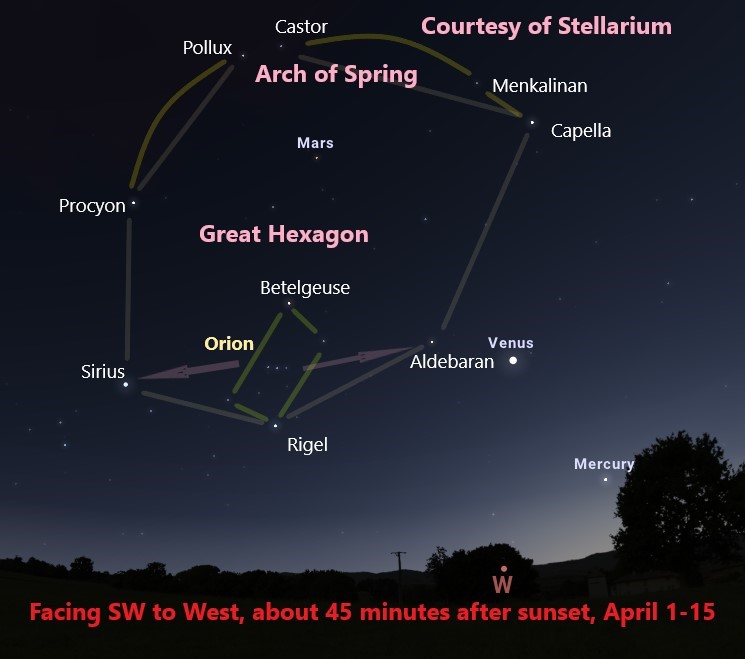Catch the Iron Planet
This April’s night sky offers a last chance to see the extraordinary accumulation of bright stars that the winter sky offers, at least at a convenient hour. It also presents the best chance to see the innermost planet, Mercury, in the evening sky this year. Messenger to the gods for the ancient Romans, in recent years Mercury has acquired the nickname of the “Iron Planet” as spacecraft have revealed that its surface is rich in that element.Mercury is usually the hardest to find of the five planets typically visible to the unaided eye. To the good side, Mercury certainly receives plenty of light since it is the closest planet to the Sun. It can be the nearest planet to us if Venus and Mars are located on the far side of the Sun as seen from Earth. But to the bad side, Mercury’s rocky surface reflects only about 12% of incoming sunlight back to us. Most importantly, since it is close to the Sun, we usually see Mercury heavily dimmed by the twilight background, in the west just after sunset or the east before sunrise. There is a story, probably not correct, that the famous astronomer Copernicus never spotted the innermost planet himself.
Due to its fast 88-day orbit around the Sun (multiply your age by 4.15 to see how old you are in Mercurian years!), there are usually three evening and three morning apparitions of Mercury each year, of varying quality. This is because Mercury’s orbit, like that of the other planets, is more or less in the plane of the solar system, and Earth’s axis is tipped relative to this plane. We see this plane in the sky as the line of the ecliptic, and the Sun, Moon, and planets move along this line, with the constellations that make up the Zodiac forming the backdrop. From the Northern Hemisphere, the ecliptic is tipped at a higher angle to the sunset horizon in the spring, and to the sunrise horizon in the fall, making these times the best to see Mercury. For example, this April’s excellent evening apparition is followed by a poor morning one at the end of May and a so-so evening appearance in July & August.
The beginning of April finds Mercury emerging into view to the lower right of brilliant Venus. Find a spot with an open view to the western horizon. The best time to look is about 45-60 minutes after sunset (about 8:15-8:30 pm in St. Louis- check your time of sunset if you are not local) and Mercury should be at its best until about the 13th, shining as the only starlike object in its area. Binoculars are useful in locating Mercury if the night isn’t exceptionally clear, or if the sky is too bright. After about the 13th, the planet rapidly grows fainter as it passes more and more between the Earth and Sun, turning its lit side away from us. With binoculars or a small telescope, you might possibly be able to track Mercury as late as the 20th, when it will appear above a super-thin crescent moon.
Once you have added the Iron Planet to your log of celestial sights, note the stars of the Great Hexagon, dominating the western and southwestern sky to the left of and above dazzling Venus. I discussed this huge grouping in last month’s blog entry, which you can read here. The upper stars of the Hexagon form a noticeable pattern known as the Arch of Spring. It seems to be most striking when the stars of Orion and Sirius are setting, around 10 or 11 o’clock in April and just after dark in May. You can learn about this celestial Arch by reviewing the May 2021 or April 2022 editions of this blog.

Our Gateway to the Stars programs for 2023 will be held on the fourth Friday of the month, from May through October. An astronomy or educational sunset program will be held inside the Arch Visitor Center or outside on our West Entrance Plaza. Weather permitting, there will also be free telescope viewing provided by the Park and by our partners with the St. Louis Astronomical Society.
